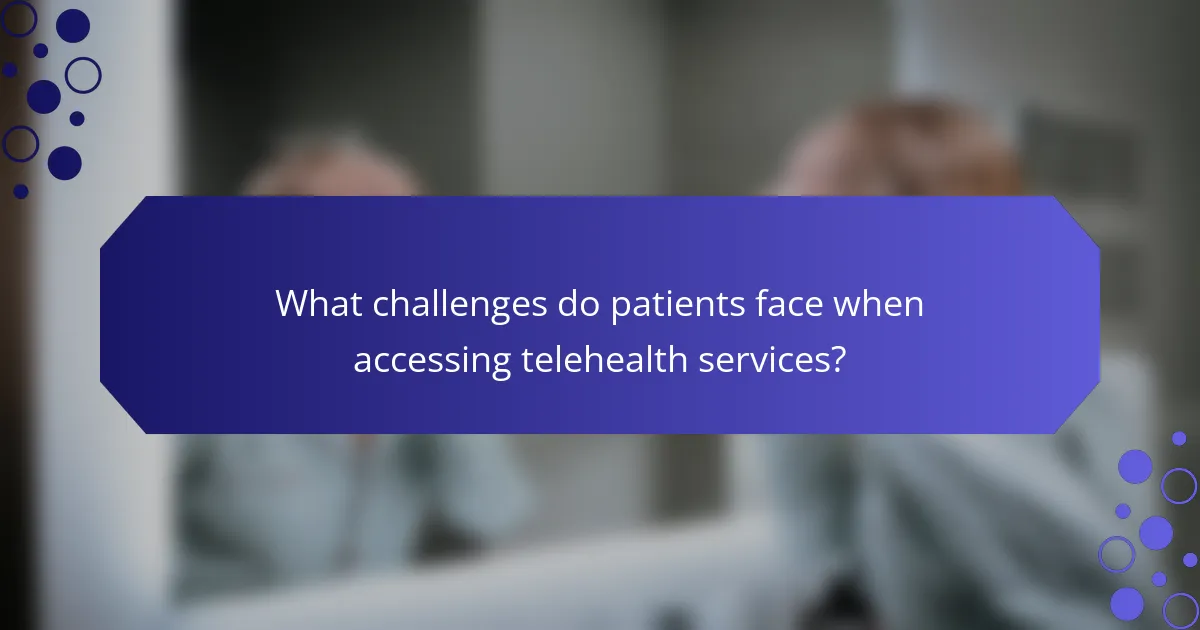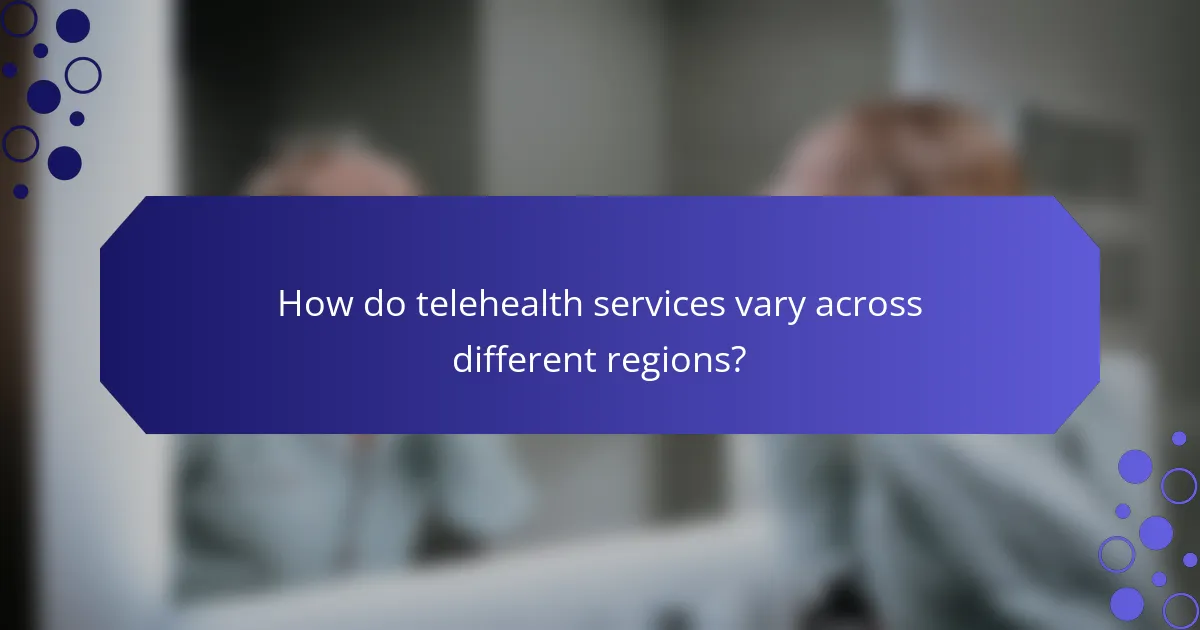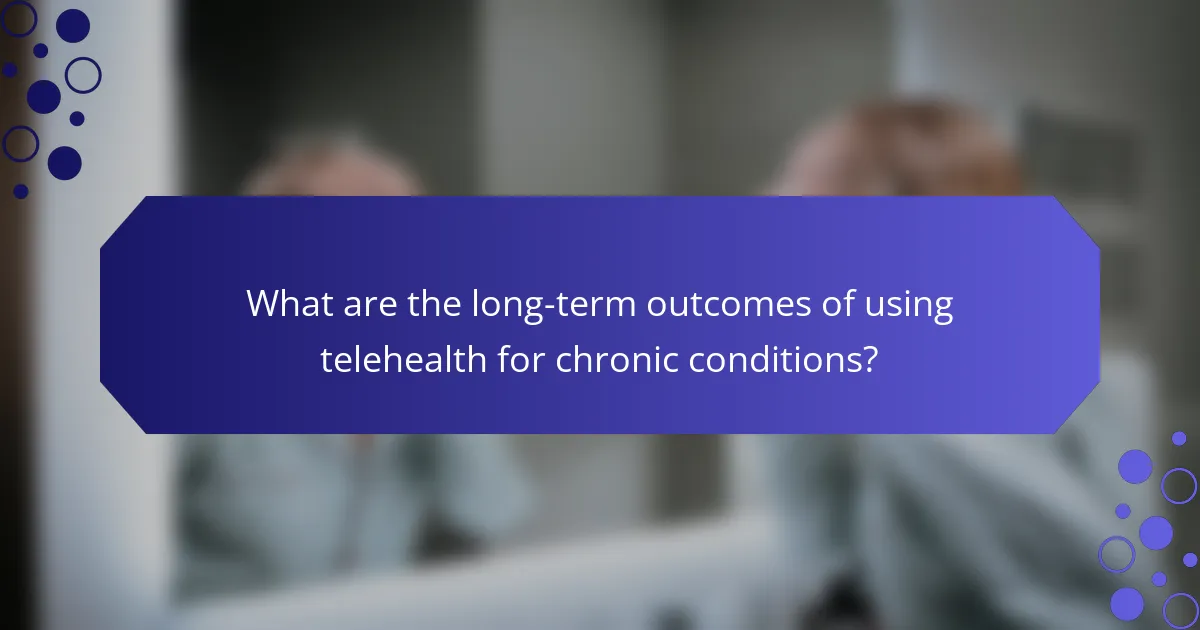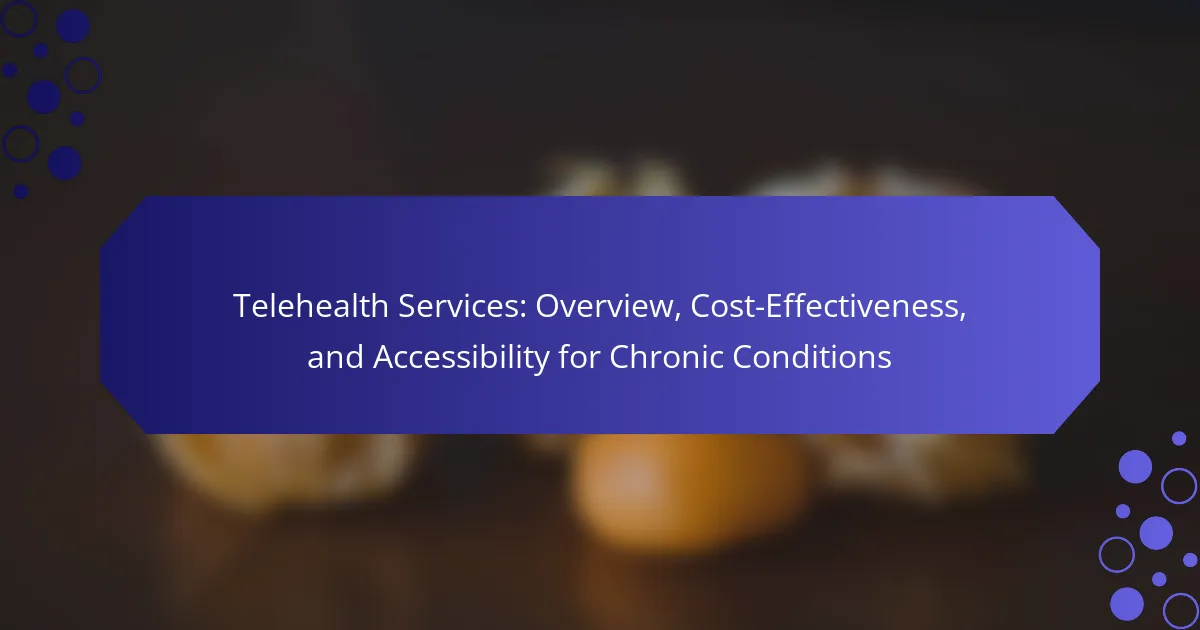Telehealth services enhance healthcare delivery for chronic conditions by providing virtual consultations, remote monitoring, and secure communication. These components improve accessibility and cost-effectiveness, reducing travel expenses and missed workdays. However, challenges such as technology barriers and varying regional access impact their effectiveness. Leading platforms offer innovative features that promote patient engagement and long-term health outcomes.

What are the essential components of telehealth services?
Telehealth services consist of essential components that enhance healthcare delivery. These include virtual consultations, remote monitoring, secure communication platforms, and electronic health records. Each component contributes to improved access and cost-effectiveness for managing chronic conditions. Virtual consultations allow patients to receive care from home, reducing travel and wait times. Remote monitoring enables healthcare providers to track patients’ health metrics in real-time, ensuring timely interventions. Secure communication platforms facilitate patient-provider interactions while maintaining confidentiality. Electronic health records streamline information sharing, enhancing care coordination.
How do telehealth services function for chronic condition management?
Telehealth services for chronic condition management use digital platforms to connect patients with healthcare providers. They facilitate remote consultations, monitoring, and follow-ups, improving access and convenience. Patients can receive personalized care plans tailored to their specific conditions, enhancing adherence and outcomes. Cost-effectiveness is notable, as it reduces travel expenses and time off work. Studies show telehealth can lead to better management of conditions like diabetes and hypertension, with improved patient satisfaction.
Which technologies are commonly used in telehealth?
Telehealth commonly utilizes technologies such as video conferencing, mobile health apps, remote monitoring devices, and secure messaging platforms. These tools enhance accessibility and cost-effectiveness for managing chronic conditions. Video conferencing enables real-time consultations, while mobile health apps facilitate patient engagement and data tracking. Remote monitoring devices allow healthcare providers to track patients’ health metrics from home, improving care continuity. Secure messaging platforms ensure confidential communication between patients and providers, fostering trust and efficiency in telehealth services.

What are the cost-saving benefits of telehealth services?
Telehealth services provide significant cost-saving benefits by reducing travel expenses and minimizing missed workdays. Patients save on transportation costs and time, while healthcare providers lower overhead expenses associated with in-person visits. Studies indicate that telehealth can decrease overall healthcare costs by up to 30%, particularly for chronic conditions. This approach not only enhances accessibility but also optimizes resource allocation, leading to more efficient healthcare delivery.
How does telehealth reduce healthcare costs for patients?
Telehealth significantly reduces healthcare costs for patients by minimizing travel expenses and enabling timely access to care. Patients save on transportation, childcare, and time off work. A study found telehealth can lower costs by 20-30% for chronic condition management. Additionally, remote monitoring reduces hospital readmissions, further decreasing overall healthcare spending.
What are the financial implications for healthcare providers?
Telehealth services can significantly impact healthcare providers financially by reducing operational costs and expanding patient reach. Cost-effectiveness arises from decreased overhead expenses, such as facility maintenance and staffing. A study indicated that telehealth can lower costs by up to 30% for chronic condition management. Additionally, telehealth enhances accessibility, potentially increasing patient volume and revenue. Providers can capitalize on this trend by integrating telehealth into their service offerings, thereby improving financial stability and patient satisfaction.

What challenges do patients face when accessing telehealth services?
Patients face several challenges accessing telehealth services, including technology barriers, limited internet access, and lack of familiarity with digital tools. These issues can hinder effective communication and lead to missed appointments. Additionally, some patients may experience concerns about privacy and data security, affecting their willingness to engage with telehealth. Accessibility varies significantly, impacting those with chronic conditions who rely heavily on consistent medical support.
How does internet connectivity impact telehealth accessibility?
Internet connectivity significantly enhances telehealth accessibility by enabling remote consultations and continuous monitoring. Reliable internet allows patients to access healthcare services from their homes, reducing travel barriers. For chronic conditions, this connectivity facilitates timely interventions, improving health outcomes. Studies show that areas with high-speed internet report higher telehealth utilization rates, underscoring the correlation between connectivity and service access.
What are the barriers to technology adoption among older adults?
Barriers to technology adoption among older adults include lack of familiarity, accessibility issues, and concerns about privacy. Many older adults may find telehealth services intimidating due to limited experience with digital devices. Additionally, physical limitations can hinder their ability to use technology effectively. Privacy concerns also play a significant role, as they may worry about data security and confidentiality. Addressing these barriers is essential for improving access to telehealth services for chronic conditions.

How do telehealth services vary across different regions?
Telehealth services vary significantly across regions due to differences in technology access, healthcare infrastructure, and regulatory environments. In urban areas, telehealth often offers comprehensive services, while rural regions may face limitations in internet connectivity and provider availability. For instance, regions with robust broadband access see higher telehealth utilization rates, enhancing accessibility for chronic conditions. Conversely, areas with less technological support may struggle to implement effective telehealth solutions, impacting cost-effectiveness and patient outcomes.
What are the differences in telehealth regulations in North America?
Telehealth regulations in North America vary significantly by country and state. The U.S. has diverse state-specific laws, while Canada maintains a more unified approach under provincial regulations.
In the U.S., regulations can differ in areas such as licensing, reimbursement, and consent requirements. For instance, some states allow out-of-state providers to offer telehealth services, while others require local licensure.
Canada’s telehealth framework is generally consistent, with provinces establishing their own rules. However, federal guidelines support broader accessibility, emphasizing equitable access to care.
Overall, understanding these regulatory differences is crucial for effective telehealth implementation across North America.
How are telehealth services perceived in urban vs. rural areas?
Telehealth services are perceived differently in urban and rural areas, primarily due to accessibility and technology availability. Urban residents often have better internet access and a wider range of telehealth options, leading to higher acceptance rates. In contrast, rural areas face challenges like limited broadband coverage and fewer healthcare providers, which can hinder telehealth adoption. As a result, while urban areas may view telehealth as a convenient alternative, rural populations may see it as a necessary solution to overcome geographic barriers.

What unique features do leading telehealth platforms offer?
Leading telehealth platforms offer unique features such as integrated patient monitoring, AI-driven symptom checkers, and personalized treatment plans. These innovations enhance user engagement and improve health outcomes for chronic conditions. Additionally, many platforms provide 24/7 access to healthcare professionals, ensuring timely support. Data security measures and compliance with healthcare regulations are also prioritized to protect patient information.
How do user experiences differ among various telehealth applications?
User experiences vary significantly among telehealth applications based on usability, features, and patient engagement. Some applications prioritize user-friendly interfaces, while others focus on comprehensive features like integrated health tracking.
Telehealth platforms also differ in accessibility, with some offering multilingual support and others focusing on specific demographics. Patient engagement strategies, such as reminders and educational resources, can enhance user experience and adherence to treatment plans.
Cost-effectiveness is another factor; applications that provide transparent pricing and insurance integration tend to improve user satisfaction. Overall, the variety in design and functionality can lead to distinct user experiences across different telehealth services.
Which telehealth platforms are gaining popularity in 2025?
Telehealth platforms gaining popularity in 2025 include Doxy.me, Teladoc, Amwell, MDLive, and Doctor on Demand. These services enhance accessibility and cost-effectiveness for managing chronic conditions. Doxy.me offers a user-friendly interface, while Teladoc provides extensive specialist access. Amwell focuses on integrated care, and MDLive emphasizes mental health services. Doctor on Demand is notable for its comprehensive primary care options. Each platform is designed to improve patient engagement and streamline healthcare delivery.

What are the long-term outcomes of using telehealth for chronic conditions?
Telehealth services can lead to improved management of chronic conditions over the long term. Patients experience enhanced access to care, resulting in better adherence to treatment plans and reduced hospitalizations. Studies indicate that telehealth reduces healthcare costs by minimizing the need for in-person visits and emergency care. Additionally, telehealth promotes patient engagement through regular monitoring and communication with healthcare providers, leading to more personalized care. Overall, the long-term outcomes of telehealth for chronic conditions include better health outcomes, increased patient satisfaction, and cost savings for both patients and healthcare systems.
How does telehealth impact patient adherence to treatment plans?
Telehealth significantly enhances patient adherence to treatment plans by providing convenient access to healthcare providers. This accessibility reduces barriers such as travel time and scheduling conflicts. Studies show that patients engaged in telehealth are more likely to follow through with prescribed treatments. Telehealth also facilitates regular communication, allowing for timely adjustments to treatment plans based on patient feedback. As a result, patients experience improved health outcomes and greater satisfaction with their care.
What evidence supports the effectiveness of telehealth interventions?
Telehealth interventions are supported by evidence demonstrating improved access to care, patient satisfaction, and health outcomes. Studies indicate that telehealth reduces hospital admissions and lowers healthcare costs. For instance, a systematic review found that telehealth services for chronic conditions led to a 25% reduction in hospital visits. Additionally, a meta-analysis showed that telehealth can enhance medication adherence by 15%. These findings underscore telehealth’s effectiveness in managing chronic conditions while promoting accessibility and cost-efficiency.

What best practices can enhance the effectiveness of telehealth services?
To enhance the effectiveness of telehealth services, implement best practices that prioritize patient engagement and streamlined communication. Clear protocols for scheduling and follow-ups improve accessibility and reduce no-show rates. Incorporating user-friendly technology ensures patients can easily navigate telehealth platforms. Regular training for healthcare providers on telehealth tools fosters confidence and efficiency in virtual consultations. Collecting patient feedback helps refine services and address specific needs, ultimately enhancing care quality for chronic conditions.
How can providers improve patient engagement in telehealth?
Providers can enhance patient engagement in telehealth by implementing personalized communication strategies and utilizing user-friendly technology. Regular follow-ups and reminders can motivate patients to participate actively. Offering educational resources tailored to individual needs fosters understanding and adherence. Additionally, incorporating feedback mechanisms allows providers to adjust services effectively, ensuring a more responsive telehealth experience.
What common mistakes should be avoided when implementing telehealth solutions?
Common mistakes to avoid when implementing telehealth solutions include inadequate training for healthcare providers, neglecting patient engagement, overlooking technology compatibility, failing to ensure data security, and not considering regulatory compliance. These errors can lead to reduced effectiveness and lower patient satisfaction. Proper planning and stakeholder involvement can mitigate these issues.
What strategies can be employed to optimize the telehealth experience?
To optimize the telehealth experience, focus on enhancing communication, ensuring user-friendly technology, and providing personalized care. Effective strategies include regular follow-ups, clear instructions for technology use, and integrating patient feedback. These approaches improve accessibility and satisfaction for chronic condition management.
